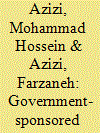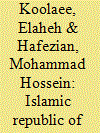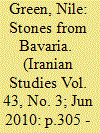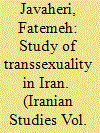|
|
|
Sort Order |
|
|
|
Items / Page
|
|
|
|
|
|
|
| Srl | Item |
| 1 |
ID:
095925


|
|
|
|
|
| Publication |
2010.
|
| Summary/Abstract |
Iranians are one of Finland's major immigrant groups. Like other asylum seekers in Finland, the Iranians brought with them their own cultural practices, attitudes and beliefs regarding marriage and family structure. The aim of this research was to study factors associated with married Iranian women's contraceptive use in Finland. A total of 120 married women with more than one child were interviewed in Turku, a costal city situated about 200km from Helsinki, the capital of Finland. The questionnaires gathered information about the respondents' socio-demographic status, knowledge and use of contraception, number of children, length of time in Finland, education level and other social characteristics. Our research shows that the social factors that are associated with the Iranian women's contraceptive use are mainly due to changes in their conditions of life and adaptation to the Finnish society.
|
|
|
|
|
|
|
|
|
|
|
|
|
|
|
|
| 2 |
ID:
095923


|
|
|
|
|
| Publication |
2010.
|
| Summary/Abstract |
The first Iranian to study medicine abroad was sent to Britain by the Iranian government in 1811, during the early decades of the Qajar period (1796-1925). The second student was sent to France in 1815, along with four other students. Another group of five students, including the third student of medicine, was sent to France in 1845. Forty-two others, including five medical students, were dispatched to France in 1858. Most members of the latter group were among the first graduates of Tehran Dar al-Fonun (House of Techniques) School. Then, in 1928, during Reza Shah Pahlavi's reign (1925-41), a special act was passed by the Iranian parliament (Majlis) according to which the Ministry of Education would send 100 students abroad annually for higher education at the government's expense. The practice was suspended in 1935 with the advent of the Second World War. Between 1928 and 1935, a total of 640 students, including 125 medical students, were sent abroad. The majority of the medical students (84 percent) were sent to France. Most of these medical graduates returned to Iran and in subsequent years played a significant role in further propagation of modern medical knowledge in the country. The paper presents a brief historical account of the conditions of public health and medical education between 1811 and 1935 as well as biographical sketches of some of the best-known or most influential medical figures among these graduates.
|
|
|
|
|
|
|
|
|
|
|
|
|
|
|
|
| 3 |
ID:
095922


|
|
|
|
|
| Publication |
2010.
|
| Summary/Abstract |
European leaders are increasingly conscious of their heavy dependence on energy supplies from Russia. In an attempt to articulate a strategy to improve energy security, the European Commission issued an EU Energy Security and Solidarity Action Plan in November 2008. This essay examines Europe's energy vulnerability and the role Iran can play in diversifying the EU energy supplies. I argue that a rapprochement with Iran aimed at greater utilization of its oil and gas reserves would contribute to Europe's (and the world's) energy security.
|
|
|
|
|
|
|
|
|
|
|
|
|
|
|
|
| 4 |
ID:
095926


|
|
|
|
|
| Publication |
2010.
|
| Summary/Abstract |
Deep geopolitical changes in the South Caucasus have considerably influenced the relationships of Iran and the three republics of Armenia, Azerbaijan and Georgia. Geographical location and strategic significance have made this region one of the most important in the world. Because of its historical affinities and socio-cultural links with the region's peoples, the Islamic Republic of Iran has expanded political-economic cooperation with them. The active presence of regional and trans-regional actors has directly affected this relation. This article mainly seeks to examine Iran's relations with the South Caucasus republics, considering the opportunities created since their independence following the collapse of the Soviet Union.
|
|
|
|
|
|
|
|
|
|
|
|
|
|
|
|
| 5 |
ID:
095921


|
|
|
|
|
| Publication |
2010.
|
| Summary/Abstract |
This essay traces the circulation of the industrial commodities of lithographic presses and stones and compares the uses to which these commodities were put in Iran with other regions at the same time. Using Persian travelogues as sources on scientific exchange, the essay compares Iran's access to lithography with its spread through Europe, Russia and South and Southeast Asia. Using lithography as a gauge of Iran's integration into an industrializing global economy, it compares state-led Iranian attempts to access lithographic commodities with attempts by other regional powers to develop local sources for these 'stones from Bavaria'. After tracing the role of Christian Evangelicalism in the technology's dissemination, the essay finally contextualizes Iranian uses of lithography in global developments in illustrated and newspaper printing.
|
|
|
|
|
|
|
|
|
|
|
|
|
|
|
|
| 6 |
ID:
095924


|
|
|
|
|
| Publication |
2010.
|
| Summary/Abstract |
Although transsexuality and change of sex might be considered a matter of personal choice, they have some socio-cultural causes and consequences. This article aims to examine these through the illustration of transsexuality in Iran. To this end, firstly, sexual transition and the legal system in Iran will be explained. Secondly, the methodology will follow. This study uses the survey method with two separate samples: 1) transsexuality policy makers and 2) forty individual cases of transsexuals. The findings reveal that while the Iranian legal system does not ban transsexuality and sexual transition, transsexuals suffering from gender identity disorder do encounter some social and cultural problems both in their private lives and publicly. The paper concludes with a summary of research findings, and sets out recommendations and study limitations.
|
|
|
|
|
|
|
|
|
|
|
|
|
|
|
|
|
|
|
|
|